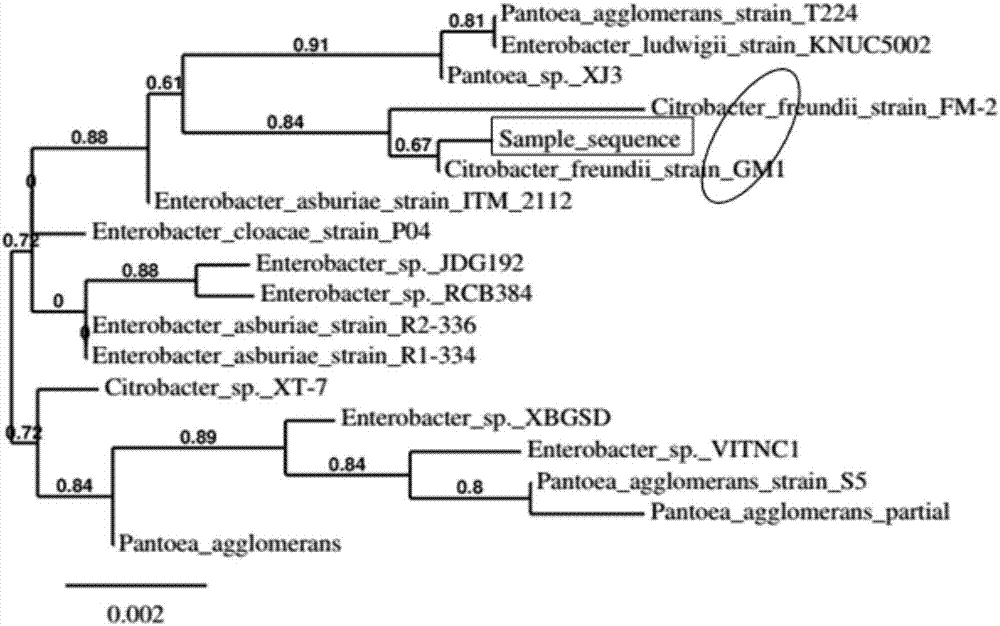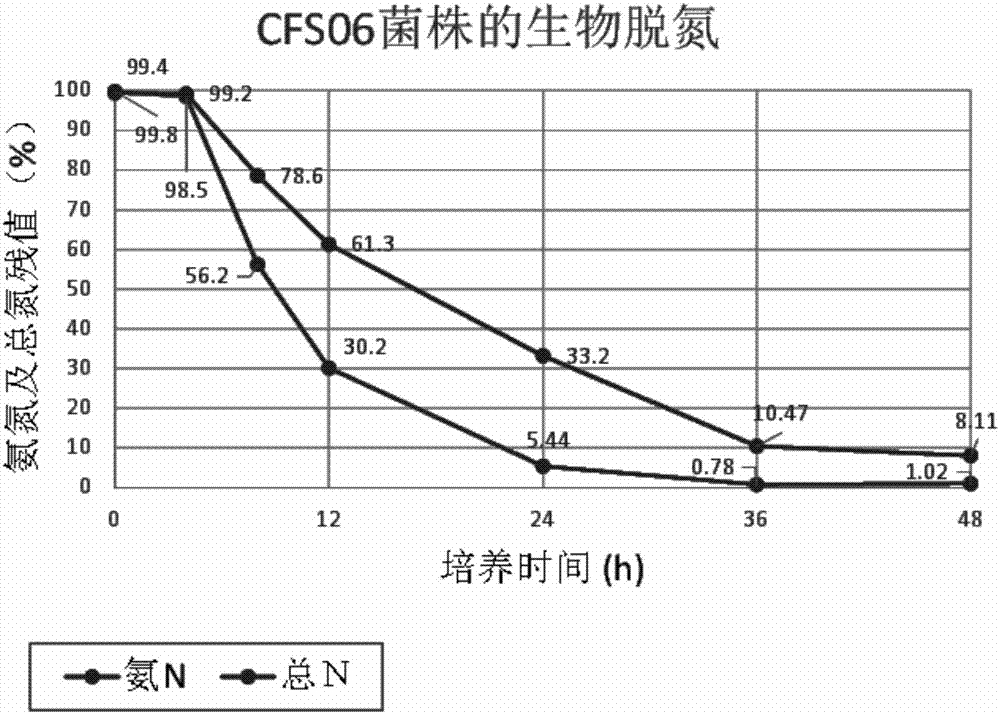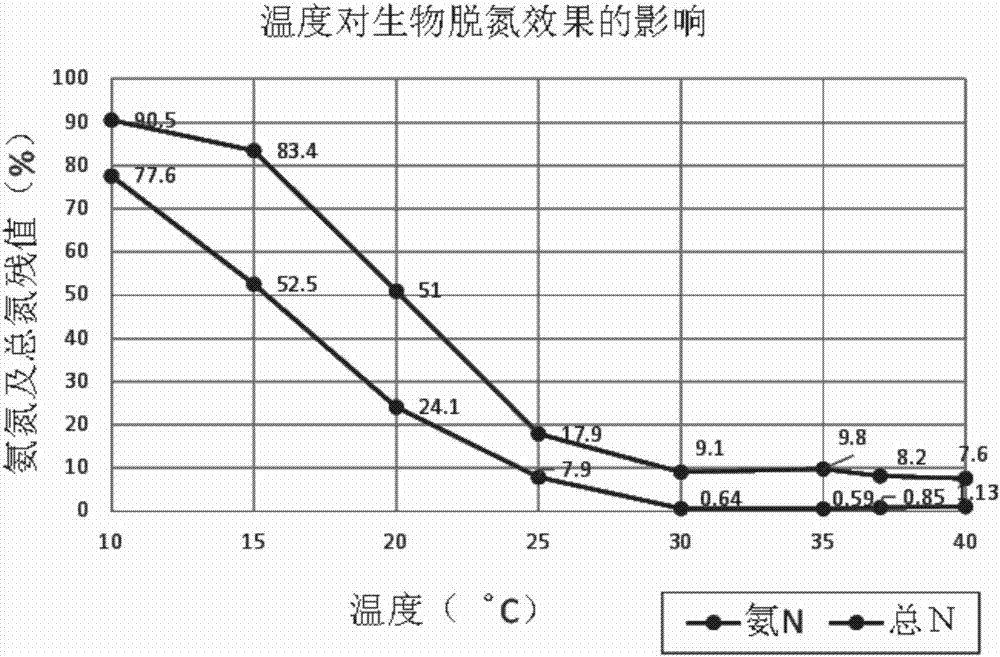Heterotrophic nitrification and aerobic denitrification Citrobacter species and application thereof
A technology of citric acid and bacillus freundii, applied in the field of applied microorganisms, can solve the problems of shortening hydraulic retention time, ammonia nitrogen cannot be processed in time, and hydraulic retention time is long, and achieves good biocatalysis function, wide temperature adaptation range, and growth adaptability. strong effect
- Summary
- Abstract
- Description
- Claims
- Application Information
AI Technical Summary
Problems solved by technology
Method used
Image
Examples
Embodiment 1
[0028] Example 1 Enrichment culture and isolation of Citrobacter freundii S06
[0029] Activated sludge is taken from the treatment tank of Shanghai Pudong Zhuyuan No. 1 Sewage Treatment Plant, and 5mL mud-water mixture is inoculated into 45mL sterilized NRM enrichment medium (the formula of NRM medium is: (NH 4 ) 2 SO 4 2.0g / L, sodium citrate 20.0g / L, MgSO 4 ·7H 2 O 1g / L, 1.0mM phosphate buffer saline K-PBS, pH 6.8. ); 30°C, 200rpm, cultured on a constant temperature shaker for 24h; then the enriched seed solution was serially diluted, and coated onto an NRM solid culture plate (NRM, containing 2% agar); cultivated in a constant temperature incubator at 30°C After 24 hours, the grown microbial clones were cultured separately, inoculated into liquid bromothymol blue (BTB) medium, and cultured in a constant temperature incubator at 30° C. for 24 hours. The formula of BTB medium is (according to per liter): KNO 3 1g, sodium succinate 8.5g, MgSO 4 ·7H 2 O 1g, CaCl 2 0....
Embodiment 2
[0030] Identification and Genetic Tree Analysis of Example 2 Bacterial Strains
[0031] Collect 2ml of fresh strain culture solution, centrifuge at 10,000g for 2min, use a genomic DNA extraction kit, such as the kit from Axygen, to extract the genomic DNA of CFS06, dissolve and dilute to 100mg / L, and use this as a template for 16S rDNA extraction For amplification, the primer pairs used are 16S-F and 16S-R, and the sequences are respectively, 16S-F: AGAGTTTGATCCTGGCTCA, and 16S-R: GGTTACCTTGTTACGACTT. The PCR reaction mixture was prepared as follows: template DNA 1 μL, PCR Taq mix 25 μL, upstream and downstream primers 1.0 μL (20 μM), add ddH 2 O to 50 μL. The PCR program was run as follows: 94°C for 5 min, 94°C for 30 s, 53°C for 1 min, 72°C for 2 min, 30 cycles, 72°C for 5 min, 4°C for 1 min. The PCR product was sequenced by a professional biological company, such as Shanghai Sangon Biotechnology Co., Ltd. The obtained sequence was analyzed by Blastn using a network tool, ...
Embodiment 3
[0033] Embodiment 3 The cultivation and biological deamination analysis of Citrobacter freundii S06
[0034] Inoculate the monoclonal colony on the LB plate into 50ml of LB liquid medium, 30°C, 200 rpm, shake culture in a 250ml shake flask for 24h, take 3% (v / v) culture solution and centrifuge at 3,000g, 2min, Wash with 1ml of NRM medium, then inoculate into 100ml of NRM liquid medium, shake and culture in a 500ml shake flask for 72h at 30°C, 200rpm, regularly sample and measure ammonia nitrogen (NH 3 -N), nitrate (NO 3 -N) and nitrite (NO 2 -N) concentration, by analyzing the residual amount of total nitrogen (TN) to measure the removal rate of the strain to inorganic nitrogen, and thus to judge the heterotrophic nitrification and aerobic denitrification performance of the strain. Depend on figure 2 It can be seen that the biological denitrification performance of the isolated strain CFS06 in the synthetic medium is very high, and it has a good denitrification performance...
PUM
 Login to View More
Login to View More Abstract
Description
Claims
Application Information
 Login to View More
Login to View More - R&D
- Intellectual Property
- Life Sciences
- Materials
- Tech Scout
- Unparalleled Data Quality
- Higher Quality Content
- 60% Fewer Hallucinations
Browse by: Latest US Patents, China's latest patents, Technical Efficacy Thesaurus, Application Domain, Technology Topic, Popular Technical Reports.
© 2025 PatSnap. All rights reserved.Legal|Privacy policy|Modern Slavery Act Transparency Statement|Sitemap|About US| Contact US: help@patsnap.com



